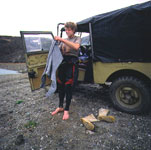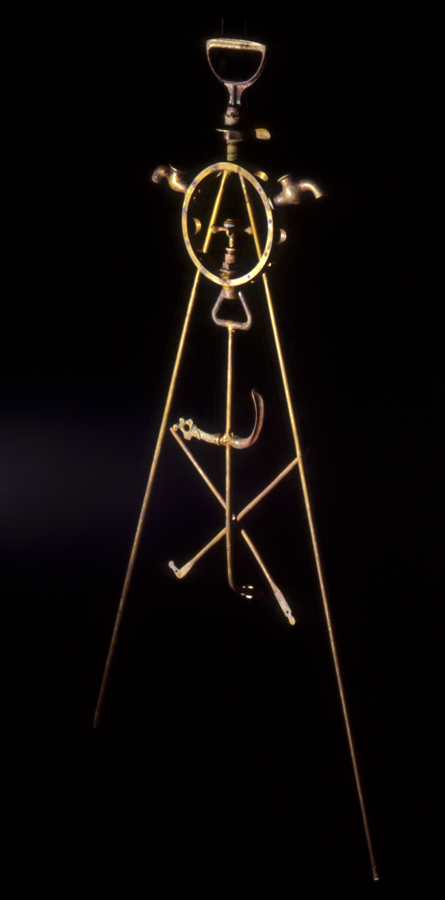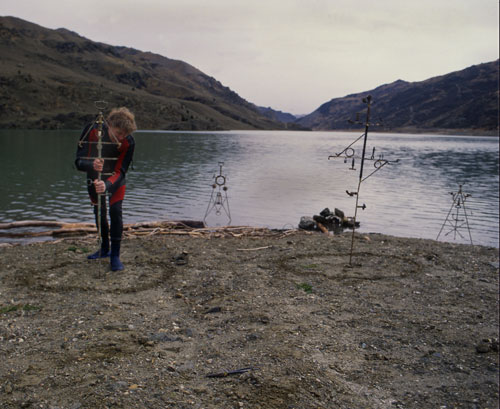 |
Lake Fill II - performance works to mark the first filling
of hydro Lake Dunstan, Clyde, New Zealand by Lloyd Godman - © Lloyd Godman

Lloyd Godman Changing before the performance work Lake Fill II |
PERFORMANCE II Aug 1993 - Lloyd Godman
On arrival the first task was to find a suitable site, a site with a flattish area sloping away to the rising water a site that faced up the old river. As we drove up and down the gorge several times searching for a suitable location, the topography looked unfamiliar, no river flowed deep in the valley, it seemed strange, and still does, to see the new lake flooded up the gorge where the river had run with such power. Where the tributaries had joined the main river, the junction points were different. Already, the first river fill had changed the river.
As with the first work, the performance was done with a consciousness of myself as an integral part of the environment, a fidelity and an attention to detail, in an attempt to introduce a physical poetry to the event. After some searching, I had found a suitable area for the performance. Although a little slanting at the top, it was a slope ran down to the river from a great rock by the road side and had a series of corrugations where it had recently been flattened out by a bull dozer. |

|
It took some time to lay out all the "ceremonial artefacts"; wire, clips, underwater camera housing etc.
|

One of the "ceremonial artefacts" used for the performance. Click on image for more. |
These artefacts had been constructed from discarded conductive metals into new tools for the performance.
As in the first performance, I dressed in the black insulation of a rubber dry suit and with slow deliberated movements began to install the various components. First was the camera itself, in an underwater housing, which had to be positioned facing up the lake and to an exact depth in the water so that the lens was giving an angle of view just above the water line. It also had to be held fast with a pile of large rocks as any movement of the housing would ruin the framing for the sequence of photographs. |
| |
As in the first performance, I dressed in the black insulation of a rubber dry suit and with slow deliberated movements began to install the various components. First was the camera itself, in an underwater housing, which had to be positioned facing up the lake and to an exact depth in the water so that the lens was giving an angle of view just above the water line. It also had to be held fast with a pile of large rocks as any movement of the housing would ruin the framing for the sequence of photographs.
After the linking of these objects, this side of the circuit ended clipped to a triangular brass plate. My arms-width apart, I placed a similar copper plate and from here the second part of the circuit ran directly back to the return wire from the camera motor drive. The installation of this circuitry was performed in slow methodical movements. Once the "Earth Circuit" was in place I lay on the ground arms out stretched to form a cruciform as in the first performance. My hands were placed on the ground just below the metal plates, and at interspersed intervals over several hours I would touch the two metal plates which would fire the motor drive and record the increase of the rise of the lake level. (When dressing, I had earlier placed a wire in the black rubber dry suit from hand to hand across my shoulders, and the symbolic connection was made through this wire).
However casual or premeditated the act may be, the taking of photographs is a ritual. The scene is selected, the framing adjusted, a light meter reading taken, the aperture and shutter settings arranged, the lens focused and perhaps the procedure checked before the shutter is tripped. The unacknowledged ritual takes place thousands of times a day where the thought and emphasis is on the image not the act. The ritual of making is generally forgotten, the physical act happens on a subconscious level. Assimilating the photo-taking act into the performance, where the process is linked directly to the artifact, is quite distinct from taking photographs of someone during a performance. As in the first performance, I incorporated this photographic ritual as part of the work, and the final sequence of photographs are a consequence of the work, not a document of the performance. While the traditional ritual of taking photographs was combined with the ritual associated with the constructed artifacts, the act was also removed by placing the camera in the water and taking the images at random intervals from a dislocated position.
Aug 1993
By the end of the second performance I had taken a second series of photographs where the lake level had risen and obscured the previous view up the lake. I deliberately left no distinct end to the performance and our leaving, as I wanted there to remain a degree of indeterminacy, the potential of a continuum.
end |
|
|

Lake Fill II - Second performance to mark the filling of hydro
lake Dunstan, Clyde, New Zealand Spetember 1993 - Lloyd Godman
|